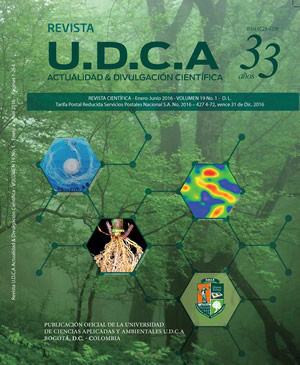Bacterias endófitas asociadas a los géneros Cyperus y Paspalum en suelos contaminados con mercurio
Endophytic bacteria associated to genus Cyperus and Paspalum in soils with mercury contamination
Contenido principal del artículo
Resumen
Palabras clave:
Descargas
Datos de publicación
Perfil evaluadores/as N/D
Declaraciones de autoría
- Sociedad académica
- Universidad de Ciencias Aplicadas UDCA
- Editorial
- Universidad de Ciencias Aplicadas y Ambientales U.D.C.A
Detalles del artículo
Referencias (VER)
ADRIANO, D.C. 2001. Trace elements in the terrestrial environment. Springer, New York. p.411-450.
ARGUMEDO, M.; VIDAL, J.; MARRUGO, J. 2013. Mercurio total en animales domésticos en Mina Santa Cruz, sur de Bolívar - Colombia. Rev. Col. Ciencia Animal. 5 (2):366-379.
BRYSON, C.; CARTER, R. 2008. The significance of Cyperaceae as weeds. Sedges, uses, diversity, and systematic of the Cyperaceae. Missouri: Monogr Syst. Bot. Mo. Bot. Gard. 108. p.15-101.
CASIERRA-POSADA, F.; AGUILAR-AVENDAÑO, O. 2007. Estrés por aluminio en plantas: reacciones en el suelo, síntomas en vegetales y posibilidades de corrección. Rev. Col. Ciencias Hort. 1(2):246-257.
CORDY, P.; VEIGA, M.; SALIH, I.; AL-SAADI, S.; CONSOLE, S.; GARCIA, O.; MESA, L.; VELÁSQUEZ-LÓPEZ, P.; ROESER, M. 2011. Mercury contamination from artisanal gold mining in Antioquia, Colombia: The world's highest per capita mercury pollution. Sci. Total Environm. 410-411:154-160.
CUI, W.; FANG, P.; ZHU, K.; MAO, Y.; GAO, C.; XIE, Y.; WANG, J.; SHEN, W. 2014. Hydrogen-rich water confers plant tolerance to mercury toxicity in alfalfa seedlings. Ecotoxicol. Environm. Safety. 105: 103-111.
DE, J.; RAMAIAH, N.; MESQUITA, A.; VERLEKAR, X. 2003. Tolerance to various toxicants by marine bacteria highly resistant to mercury. Marine Biotechn. 5(2):185-193.
ESCALANTE-ESPINOSA, E.; GALLEGOS-MARTÍNEZ, M.; FAVELA-TORRES, E.; GUTIERREZ-ROJAS, M. 2005. Improvement of the hydrocarbon phytoremediation rate by Cyperus laxus Lam. inoculated with a microbial consortium in a model system. Chemosphere. 59:405-413.
EVERS, G.; BURSON, B. 2004. Dallisgrass and other Paspalum species. In: Moser, L.E.; Burson, B.L.; Sollenberger, L.E. (eds). Warm-Season (C4) Grasses, Agronomy Monographs 45. eds. Madison, Wisconsin. p.681-713.
HOLMES, P.; JAMES, K.; LEVY, L. 2009. Is low-level environmental mercury exposure of concern to human health? Sci. Total Environm. 408(2):171-182.
INSTITUTO GEOGRÁFICO AGUSTÍN CODAZZI -IGAC-. 2015. ¿Cómo realizar la toma de muestras para suelos? Disponible desde internet en: http://www.igac.gov.co/wps/portal/igac/raiz/iniciohome/tramites/!ut/p/ c4/04_SB8K8xLLM9MSSzPy8xBz9CP0os3hHT3d_ JydDRwN3t0BX A0 _vUKMwf2 8PI4 NQI_2C b EdF AJ67 NCc!/?WCM_PORTLET=PC_7 _ AIGOBB1A08AGF0ISG6J8NS30 (con acceso 26/03/2015).
JIANG, C.; SHENG, X.; QUIAN, M.; WANG, Q. 2008. Isolation and characterization of a heavy metalresistant Burkholderia sp. from heavy metalcontaminated paddy field soil and its potential in promoting plant growth and heavy metal accumulation in metal-polluted soil. Chemosphere. 72(2):157-164.
KABATA-PENDIAS, A. 2011. Trace elements in soils and plants. 4th ed. CRC Press, Boca Ratón (Estados Unidos). p.304-312.
LODEWYCKX, C.; TAGHAVI, S.; MERGEAY, M.; VANGRONSVELD, J.; CLIJSTERS, H.; VAN DER LELIE, D. 2001. The effect of recombinant heavy metal resistant endophytic bacteria in heavy metal uptake by their host plant. Int. J. Phytoremed. 3:173- 187.
LÓPEZ-MARTÍNEZ, S.; GALLEGOS-MARTÍNEZ, M.; PÉREZ-FLORES, L.; GUTIÉRREZ-ROJAS, M. 2008. Contaminated soil phytoremediation by Cyperus laxus Lam. cytochrome p450 erod-activity induced by hydrocarbons in roots. Int. J. Phytoremed. 10:289-301.
LUO, S.; CHEN, L.; CHEN, J.; XIAO, X.; XU, T.; WAN, Y.; RAO, C.; LIU, C.; LIU, Y.; LAI, C.; ZENG, G. 2011. Analysis and characterization of cultivable heavy metal-resistant bacterial endophytes isolated from Cd-hyperaccumulator Solanum nigrum L. and their potential use for phytoremediation. Chemosphere. 85:1130-1138.
MA, Y.; PRASAD, M.; RAJKUMAR, M.; FREITAS, H. 2011. Plant growth promoting rhizobacteria and endophytes accelerate phytoremediation of metalliferous soils. Biotechnol. Adv. 29:248-258.
MA, Y.; OLIVEIRA, R.; NAI, F.; RAJKUMAR, M.; LUO, Y.; ROCHA, I.; FREITAS, H. 2015. The hyperaccumulator Sedum plumbizincicola harbors metal-resistant endophytic bacteria that improve its phytoextraction capacity in multi-metal contaminated soil. J. Environm. Managem. 156:62-69.
MARRUGO-NEGRETE, J.; DURANGO-HERNÁNDEZ, J.; PINEDO-HERNÁNDEZ, J.; OLIVERO- VERBEL, J.; DÍEZ, S. 2015. Phytoremediation of mercury-contaminated soils by Jatropha curcas. Chemosphere. 127:58-63.
MORENO, F.; ANDERSON, C.; STEWART, R.; ROBINSON, B. 2008. Phytofiltration of mercury-contaminated water: Volatilisation and plant-accumulation aspects. Environm. Exp. Bot. 62:78-85.
NITHYA, C.; GNANALAKSHMI, B.; PANDIAN, S. 2011. Assessment and characterization of heavy metal resistance in Palk Bay sediment bacteria. Marine Environm. Res. 71(4):283-294.
OLARTE, L.; MUÑOZ, B.; BENAVIDES, G.; GARAVITO, F.; LUNA, C.; MEJÍA, L.; ROZO, E. 1979. Métodos analíticos del laboratorio de suelos. Instituto Geográfico Agustín Codazzi. 4a. ed. Bogotá, Colombia.
OLIVEIRA, M.; SANTOS, T.; VALE, H.; DELVAUX, J.; CORDERO, P.; FERREIRA, A.; MIGUEL, P.; TOTOLA, M.; COSTA, M.; MORAES, C.; BORGES, A. 2013. Endophytic microbial diversity in coffee cherries of Coffea arabica from southeastern Brazil. Can. J. Microbiol. 59:221-30.
PÉREZ, A.; ROJAS, J.; FUENTES, J. 2010. Diversidad de bacterias endófitas asociadas a raíces del pasto colosuana (Bothriochloa pertusa) en tres localidades del departamento de Sucre, Colombia. Acta Biol. Col. 15 (2):219-228.
PÉREZ, A.; ARROYO, E.; CHAMORRO, A. 2015. Resistencia a níquel en bacterias endófitas aisladas a partir de Oriza sativa en Colombia. Rev. Soc. Venez. Microbiol. 35:20-25.
POSCHENRIEDER, C.; BARCELÓ, J. 2003. Estrés por metales pesados. In: Reigosa, M.J., Pedrol, N., Sánchez, A. (eds.). Ecofisiología Vegetal. Madrid. p.413-442.
RAJKUMAR, M.; NORIHARU, A.; FREITAS, H. 2009. Endophytic bacteria and their potential to enhance heavy metal phytoextraction. Chemosphere 77:153- 160.
RANJARD, L.; BROTHIER, E.; NAZARET, S. 2000. Sequencing bands of ribosomal intergenic spacer analysis fingerprints for characterization and microscale distribution of soil bacterium populations responding to mercury spiking. Appl. Environm. Microbiol. 66(12):5334-5339.
SÁNCHEZ, E.; CURETTI, M. 2006. Los suelos salinos y sódicos. Fruticult. Diversific. 12(49):10-13.
SORKHOH, N.; ALI, N.; DASHTI, N.; AL-MAILEM, D.; AL-AWADHI, H.; ELIYAS, M.; RADWAN, S. 2010. Soil bacteria with the combined potential for oil utilization, nitrogen fixation and mercury resistance. Int. Biodeterior. Biodegr. 64:226-231.
TERÁN-MITA, T.; FAZ, A.; SALVADOR, F.; AROCENA, J.; ACOSTA, J. 2013. High altitude artisanal small-scale gold mines are hot spots for mercury in soilsand plants. Environm. Poll. 173:103-109.
VAN OVERBEEK, L.; BERGERVOET, J.; JACOBS, F.; VAN ELSAS, J. 2004. The low-temperature-induced viable-but nonculturable state affects the virulence of Ralstonia solanacearum biovar 2. Phytopathology. 94:463-469.
VIDAL, J.; MARRUGO, J.; JARAMILLO, B.; PEREZ, L. 2010. Remediación de suelos contaminados con mercurio utilizando guarumo (Cecropia peltata). Ing. Desarrollo. 27:113-129.
WANG, Y.; GREGER, M. 2004. Clonal differences in mercury tolerance, accumulation, and distribution in willow. J. Environm. Quality. 33:1779-1785.
WEYENS, N.; VAN DER LELIE, D.; TAGHAVI, S.; VANGRONSVELD, J. 2009. Phytoremediation: plantendophyte partnerships take the challenge. Current Opinion Biotechn. 20:248-254.
YADAV, S. 2010. Heavy metals toxicity in plants: An overview on the role of glutathione and phytochelatins in heavy metal stress tolerance of plants. South Afr. J. Bot. 76:167-179.







